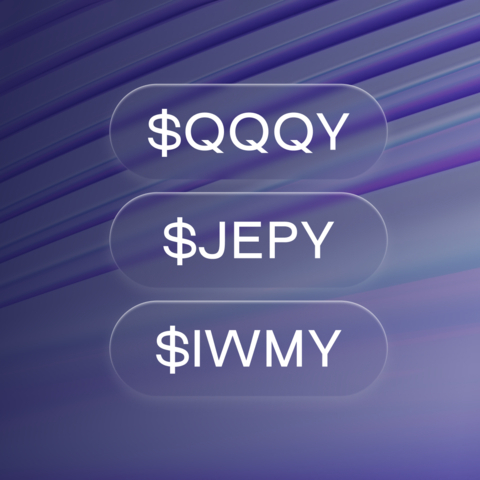Defiance Suite of Daily Options (0DTE) Income ETFs, $QQQY, $JEPY & $IWMY Surpass $400M AUM

https://www.defianceetfs.com/ (Graphic: Business Wire)
JEPY, QQQY, and IWMY represent Defiance ETFs' commitment to providing investors with innovative income solutions in today's dynamic markets. JEPY focuses on the S&P 500, while QQQY offers enhanced income opportunities within the Nasdaq-100 Index, and IWMY offers enhanced income opportunities within the Russell 2000.
Monthly Distributions:
QQQY (
JEPY (
IWMY (
Distribution as of 11/30/2023
ETF
|
Distribution
|
Distribution
|
Ex-Date |
Record
|
Payment
|
QQQY |
|
|
12/1/2023 |
12/4/2023 |
12/6/2023 |
JEPY |
|
|
12/1/2023 |
12/4/2023 |
12/6/2023 |
IWMY |
|
|
12/1/2023 |
12/4/2023 |
12/6/2023 |
QQQY Inception Date: 9/13/2023
Click here for QQQY Standardized Performance.
JEPY Inception Date: 9/18/2023
Click here for JEPY Standardized Performance
IWMY Inception Date: 10/30/2023
Click here for IWMY Standardized Performance
About Us: Defiance ETFs, founded in 2018, has emerged as a leading ETF issuer dedicated to income and thematic investing. The firm's actively managed options ETFs are designed to potentially enhance income for investors, with distributions paid on a monthly basis 1
The performance data quoted above represents past performance. Past performance does not guarantee future results. The investment return and principal value of an investment will fluctuate so that an investor’s shares, when sold or redeemed, may be worth more or less than their original cost and current performance may be lower or higher than the performance quoted above. Performance current to the most recent month-end can be obtained by calling 833.333.9383.
1 The funds intend to pay distributions, if any, on a monthly basis
As of 11-30-2023 the 30-Day SEC yield** for QQQY is
The Gross Expense Ratio for QQQY, JEPY, and IWMY is
Click here for the QQQY Prospectus.
Click here for the JEPY Prospectus.
Click here for the IWMY Prospectus.
* The Distribution Rate is the annual yield an investor would receive if the most recently declared distribution, which includes option income, remained the same going forward. The Distribution Rate is calculated by multiplying an ETF’s Distribution per Share by twelve (12), and dividing the resulting amount by the ETF’s most recent NAV. The Distribution Rate represents a single distribution from the ETF and does not represent its total return. Distributions are not guaranteed.
** The Distribution Rate and 30-Day SEC Yield is not indicative of future distributions, if any, on the ETFs. In particular, future distributions on any ETF may differ significantly from its Distribution Rate or 30-Day SEC Yield. You are not guaranteed a distribution under the ETFs. Distributions for the ETFs (if any) are variable and may vary significantly from month to month and may be zero. Accordingly, the Distribution Rate and 30-Day SEC Yield will change over time, and such change may be significant. The distribution may include a combination of ordinary dividends, capital gain, and return of investor capital, which may decrease a fund's NAV and trading price over time. As a result, an investor may suffer significant losses to their investment. These distribution rates caused by unusually favorable market conditions may not be sustainable. Such conditions may not continue to exist and there should be no expectation that this performance may be repeated in the future. Additional fund risks can be found below.
“Investors should consider the investment objectives, risks, charges and expenses carefully before investing. For a prospectus or summary prospectus with this and other information about the Fund, please call 833.333.9383. Read the prospectus or summary prospectus carefully before investing.”
Investing involves risk. Principal loss is possible. As an ETF, the funds may trade at a premium or discount to NAV. Shares of any ETF are bought and sold at market price (not NAV) and are not individually redeemed from the Fund. Brokerage commissions will reduce returns.
The Distribution Rate is the annual yield an investor would receive if the most recently declared distribution, which includes option income, remained the same going forward. The Distribution Rate is calculated by multiplying an ETF’s Distribution per Share by twelve (12), and dividing the resulting amount by the ETF’s most recent NAV. The Distribution Rate represents a single distribution from the ETF and does not represent its total return. Distributions are not guaranteed.
An Investment in the Funds is not an investment in the Index, nor are the Funds an investment in a traditional passively managed index fund.
QQQY Index Overview: The Nasdaq 100 Index is a benchmark index that includes 100 of the largest non-financial companies listed on the Nasdaq Stock Market, based on market capitalization. This makes it a large-cap index, meaning its constituents have a high market value, often in the billions of dollars. The Index includes companies from various industries but is heavily weighted towards the technology sector. This reflects the Nasdaq’s historic strength as a listing venue for tech companies. Other sectors represented include consumer discretionary, health care, communication services, and industrials, among others.
JEPY Index Overview: The S&P 500 Index is a widely recognized benchmark index that tracks the performance of 500 of the largest
IWMY Index Overview: The Russell 2000 Index is a widely recognized benchmark index that tracks the performance of approximately 2000 small-cap companies in
QQQY Indirect Investment Risk. The Index is not affiliated with the Trust, the Fund, the Adviser, the Sub-Adviser, or their respective affiliates and is not involved with this offering in any way. Investors in the Fund will not have the right to receive dividends or other distributions or any other rights with respect to the companies that comprise the Index but will be subject to declines in the performance of the Index. The Nasdaq 100 Index is a benchmark index that includes 100 of the largest non-financial companies listed on the Nasdaq Stock Market, based on market capitalization. This makes it a large-cap index, meaning its constituents have a high market value, often in the billions of dollars.
JEPY Indirect Investment Risk. The Index is not affiliated with the Trust, the Fund, the Adviser, the Sub-Adviser, or their respective affiliates and is not involved with this offering in any way. Investors in the Fund will not have the right to receive dividends or other distributions or any other rights with respect to the companies that comprise the Index but will be subject to declines in the performance of the Index.
IWMY Indirect Investment Risk. The Index is not affiliated with the Trust, the Fund, the Adviser, the Sub-Adviser, or their respective affiliates and is not involved with this offering in any way. Investors in the Fund will not have the right to receive dividends or other distributions or any other rights with respect to the companies that comprise the Index but will be subject to declines in the performance of the Index.
Index Trading Risk. The trading price of the Index may be highly volatile and could continue to be subject to wide fluctuations in response to various factors. The stock market in general has experienced extreme price and volume fluctuations that have often been unrelated or disproportionate to the operating performance of companies.
S&P 500 Index Risks: The Index, which includes a broad swath of large
The Nasdaq 100 Index Risks: The Index’s major risks stem from its high concentration in the technology sector and significant exposure to high-growth, high valuation companies. A downturn in the tech industry, whether from regulatory changes, shifts in technology, or competitive pressures, can greatly impact the index. It’s also vulnerable to geopolitical risks due to many constituent companies having substantial international operations. Since many of these tech companies often trade at high valuations, a shift in investor sentiment could lead to significant price declines.
The Russell 2000 Index Risks: The Index, which includes a broad swath of large
Derivatives Risk. Derivatives are financial instruments that derive value from the underlying reference asset or assets, such as stocks, bonds, or funds (including ETFs), interest rates or indexes. The Fund's investments in derivatives may pose risks in addition to, and greater than, those associated with directly investing in securities or other ordinary investments, including risk related to the market, imperfect correlation with underlying investments, higher price volatility, lack of availability, counterparty risk, liquidity, valuation and legal restrictions.
Price Participation Risk. The Fund employs an investment strategy that includes the sale of in-the-money put option contracts, which limits the degree to which the Fund will participate in increases in value experienced by the Index over the Call Period (typically, one day, but may range up to one week). This means that if the Index experiences an increase in value above the strike price of the sold put options during a Call Period, the Fund will likely not experience that increase to the same extent and may significantly underperform the Index over the Call Period. Additionally, because the Fund is limited in the degree to which it will participate in increases in value experienced by the Index over each Call Period, but has full exposure to any decreases in value experienced by the Index over the Call Period, the NAV of the Fund may decrease over any given time period.
Distribution Risk. As part of the Fund's investment objective, the Fund seeks to provide current monthly income. There is no assurance that the Fund will make a distribution in any given month. If the Fund does make distributions, the amounts of such distributions will likely vary greatly from one distribution to the next.
New Fund Risk. The Fund is a recently organized management investment company with no operating history. As a result, prospective investors do not have a track record or history on which to base their investment decisions.
High Portfolio Turnover Risk. The Fund may actively and frequently trade all or a significant portion of the Fund’s holdings. A high portfolio turnover rate increases transaction costs, which may increase the Fund’s expenses.
Liquidity Risk. Some securities held by the Fund, including options contracts, may be difficult to sell or be illiquid, particularly during times of market turmoil. This risks greater for the Fund as it will hold options contracts on a single security, and not a broader range of options contracts.
Disclosures: Defiance ETFs LLC is the ETF sponsor. The Fund’s investment adviser is Toroso Investments, LLC (“Toroso” or the “Adviser”). The Fund Administrator is Tidal ETF Services LLC. The investment sub-adviser is ZEGA Financial, LLC (“ZEGA” or the “Sub-Adviser”).
JEPY, QQQY, and IWMY are distributed by Foreside Fund Services, LLC.
View source version on businesswire.com: https://www.businesswire.com/news/home/20231219873698/en/
Frank Taylor
(646) 808-3647
defiance@dlpr.com
Source: Defiance ETFs







